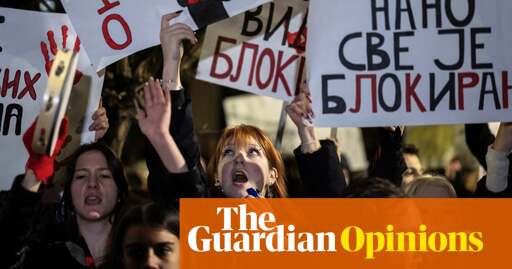When a building structure collapses because it is old, as happened in Dresden a few months ago, people naturally respond with disbelief and disapproval of the authorities. It is a different story when new buildings crumble and kill people. The 1 November 2024 collapse of the concrete canopy of a railway station in Novi Sad, Serbia – whose restoration was completed only months earlier, accompanied by great government pomp – killed 15 people, and has sparked continuing nationwide outrage and indignation. The mass protests have forced the prime minister to resign and put the president under increasing pressure.
…
But then came the students. Last month, their peaceful vigils silently commemorating the 15 victims in front of the Faculty of Dramatic Arts in Belgrade were violently interrupted by a bunch of thugs posing as impatient drivers. It was alleged shortly after that they were closely related to the ruling party, some of them its members, and the Serbian president went on national TV to defend the provocateurs. It was revealed that people close to the regime were given instructions to disrupt the moments of silence. To defend the businesses of the oligarchy, violence seems to have been only allowed but also prescribed.
In response, students at public universities across Serbia declared strike action, halting the operation of their schools. By the end of December, they were joined by a significant number of high school pupils. Others joined too: agricultural workers – also unhappy with the way the government had been treating them for years – backed the students’ demands. The Bar Association of Serbia was next. Performances in theatres ended with actors holding banners reading, “The students have risen. What about the rest of us?”. The public was not indifferent: about 100,000 people gathered on 22 December at Belgrade’s Slavija Square, standing in silence for 15 minutes. Last weekend, on the three-month anniversary of the station accident, unprecedented numbers swelled into the streets of Novi Sad, and a growing, countrywide movement now includes school teachers, cultural workers, bikers protecting the rallies, engineers and taxi drivers. Peaceful vigils took place in more than 200 towns and villages. On the protesters’ faces was a peculiar mixture of solemnity, indignation, pride and hopefulness. It is a combination that has come to represent the present moment in Serbia.
…
What the Serbian students are doing is nothing less than restoring democratic hope in a country that has seen too little of it – and at a time when it is crumbling worldwide.



My understanding is that there isn’t really an obvious opposition party, right? Do you think once big-lips is finally gone that the replacement will be a complicated German-style coalition?
That’s a tough question, I gave a more detailed answere here: https://slrpnk.net/comment/13457345
The opposition parties are not very popular, but the general idea is that we need to primarily get our institutions to actually function so that another Vucic doesn’t happen again, no matter who forms the government. Nobody really knows how this will play out exactly, since the students are vocal about the fact that they’re unaffiliated with any opposition or NGO, which is one of the reasons why they are so popular with the people. All major opposition parties rejected the idea of participating in any snap elections this year, and the students are asking for an expert transitional government to enable free elections. This is something most people support.
Thank you for writing that longer post, it fills in a lot of detail that my friend tried to explain. It sounds like that transitional period will be VERY precarious. Would Serbians consider the help of an international group (the UN, or whoever you choose) to help keep things stable?